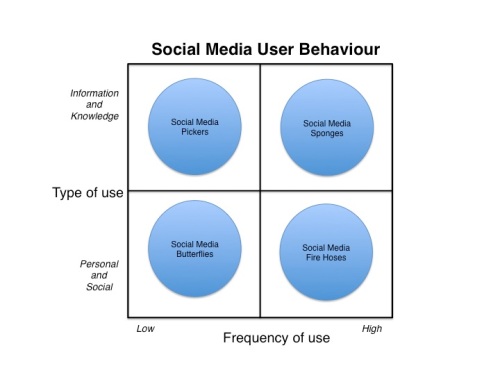How people use social media is a frequent conversation that I seem to encounter. Some will say they just “love Facebook” or they are spending a “lot of time on Pinterest” and so on. But there is a broader perspective here beyond which social media sites are used, and I have found it helpful to consider user behaviour in social media along two dimensions.
One is the frequency of use recognizing that some people are casual or infrequent users, and may view social media to be somewhat incidental to their personal or business lives. At the other end of this scale, some people are very heavily involved in the use of social media, and may well be obsessed with it. For these people, it may be that they access social media in some form every hour of every day.
The other dimension relates to the type of use of social media. For some people, it may be they focus only on the personal side such as connections and contacts with friends, the sharing of photos of their travels and so on. Typically, this is more conversational and the main objective is the contact rather than the content. Others however will be more content focused and use social media to access a wide range of information and knowledge on their topics of interest whether it be news and current affairs, history or hobbies. Communities of interest on social media form an important part of information and content sharing. LinkedIn for example has well over 1 million different groups that have the ability to share information and content, and collaborate amongst the group members.
The figure below blends these two dimensions and highlights four major categories of how people use social media.
The first of these in the bottom left quadrant is the group we can label as the Social Media Butterflies. This behaviour is focused around personal and social use such as contact and conversations with friends, but with infrequent use. These users may access their social media sites on a very infrequent basis or may also be quite passive in the way they participate. In other words, they may have a burst of activity when they have some spare time or when they go on holidays for example.
Another group is also aligned to personal and social activity, but are high frequency users. These are the Social Media Fire Hoses shown in the bottom right quadrant of the matrix. Their activity on social media is not only highly visible, but is also very intense in terms of frequency and profile. They are heavy users of social media which forms and significant part of their daily lives. They will be active through their smartphones and tablets meaning they can and do participate whenever and wherever they are.
The top left quadrant of the matrix shows the so-called Social Media Pickers who are not frequent users of social media, but who will access particular information and knowledge when they require. Their focus is more on content rather than contact. For instance, they may access the social media sites for certain magazines or journals, or may go exploring for information on areas of interest such as sport.
Finally, the top right quadrant shows the position of the Social Media Sponges. These users are frequently engaged with social media, but with the major focus on accessing and sharing of content. They link themselves to various media sites, journals, thinks tanks, consultancies and so on, and spend considerable time on content by accessing information and knowledge across a range of topics and interests.
But there is no right or wrong positioning here. Everyone will work out their own positioning and balance, and this is likely to change over time. Those exploring social media for the first time may start tentatively as low-frequency users but over time they may find they become high frequency users because of contact with family and friends. Others may have a very different experience.
The pattern may also vary depending on the tools being used. A person may well be a Social Media Butterfly on Facebook and access photos or family contacts from time to time, but at the same time may be a Social Media Sponge on Twitter and follow many business and media sites that provide regular updates on articles of interests.
The richness of social media today provides immense variety for how people use it and to reap the benefits of participating in this fascinating medium.

